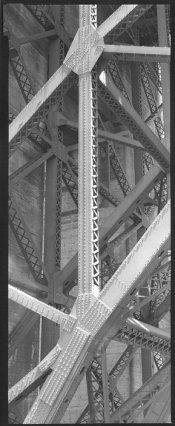I print carbons from camera negatives only.
How I expose and develop the negative all depends of the brightness range of the original scene. If the scene has 13 or more stops in it, I can pretty much expose to put the shadows in Zone III (read the shadows and subtract two stops) and let the highlights run out to where they want to go with 'normal' development. Such as the sea cave below. I think it is on Tri-X in HC-110, Dil B for perhaps 7 minutes (constant agitiation in a tray -- but this is from memory from about 1993).
Less range of light in the scene requires the same exposure but up to 100% more development. Lately I have been using Ilford PQ Universal developer or Dektol at paper strength or stronger with nice results, as in the image of the girders of Golden Gate Bridge (though it could have used a little more development). It was developed in straight Dektol at 70F for 10 minutes in a Jobo drum (this year, so I am pretty sure of its development!).
If the subject only has 4 or 5 stops of range of light, I usually don't bother trying to get a negative for carbon printing -- but I can get one for platinum (I do not use a contrast-boosting agent).
PS -- it may not show it in the image on the screen, but the sun-lit sand has full detail. I have a pure black in some of the areas of the inside of the cave. My Pentax Spot Meter read 0 up there, but I did not not know how much below 0 it actually was -- so it is clear on the neg...no matter to the image. The sand read 13.
You may not be able to scan a negative easily that has the range I want for carbon printing -- it would have a hard time punching thru the highlights!







